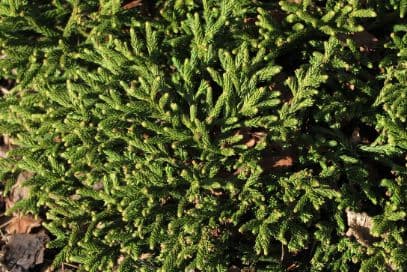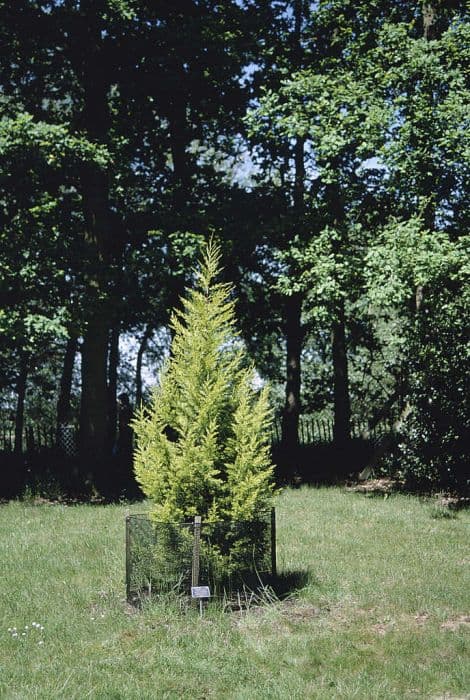Dawn redwood Metasequoia glyptostroboides

ABOUT
The plant commonly known as the dawn redwood is a unique and visually striking deciduous conifer. It is characterized by a pyramidal shape and a trunk with attractive, reddish-brown bark that becomes deeply fluted with age. In spring, the dawn redwood sprouts feathery, fresh green needles that provide a soft, airy texture. As the seasons change, these needles turn to a rich coppery-orange hue before shedding in the fall, a feature that adds seasonal interest to the landscape. The foliage of this tree is arranged in opposite pairs and it bears cones that are small and globular, appearing in clusters. The branches of the dawn redwood are horizontal and may gently weep at the ends, which contributes to its elegant and slightly pendulous appearance. The overall form of the tree is well balanced and harmonious, offering a stately element in any space where the details of its size are not a constraint.
About this plant
 Names
NamesFamily
Cupressaceae
Synonyms
Dawn Redwood, Water Fir, Shuishan
Common names
Metasequoia glyptostroboides.
 Toxicity
ToxicityTo humans
The Dawn Redwood is generally recognized as non-toxic to humans. There are no well-documented cases of poisoning or adverse reactions from ingesting or handling parts of the Dawn Redwood tree. It's important to note that despite its safety record, it is always prudent not to ingest plant material that is not explicitly intended for human consumption.
To pets
The Dawn Redwood is generally considered to be non-toxic to pets. There are no significant reports of poisoning or health issues arising from pets ingesting parts of the Dawn Redwood tree. However, as with any non-food plant, ingestion of large amounts may cause gastrointestinal discomfort due to the fiber content or natural compounds that are not part of an animal's typical diet.
 Characteristics
CharacteristicsLife cycle
Perennials
Foliage type
Deciduous
Color of leaves
Green
Height
70 feet 21.336 meters
Spread
25 feet 7.62 meters
Plant type
Tree
Hardiness zones
5
Native area
China
Benefits
 General Benefits
General Benefits- Ornamental Value: Metasequoia glyptostroboides, commonly known as Dawn Redwood, is highly prized for its majestic pyramidal shape, which adds decorative value to landscapes.
- Shade Providing: Its large size and dense foliage offer substantial shade in parks and large gardens.
- Historical Significance: Being a "living fossil," the Dawn Redwood offers an educational and historical element to gardens and educational programs.
- Fast Growth: Dawn Redwood is known for its rapid growth rate which can swiftly create visual impact and fulfill landscaping needs.
- Seasonal Interest: It provides seasonal interest with bright green needles in spring and summer, turning to a reddish-brown in the fall before shedding.
- Erosion Control: The robust root system can help stabilize soil and control erosion on riverbanks and slopes.
- Wildlife Habitat: Provides habitat for birds and other wildlife, offering nesting sites and shelter.
- Cultural Significance: In some cultures, the tree is considered symbolic and is planted in significant locations or for ceremonial purposes.
- Adaptability: It is adaptable to a range of soil types and urban pollution, making it suitable for urban environments.
- Carbon Sequestration: As a large tree, it has a significant capacity for carbon sequestration, contributing to the mitigation of climate change.
 Medical Properties
Medical PropertiesThis plant is not used for medical purposes.
 Air-purifying Qualities
Air-purifying QualitiesThis plant is not specifically known for air purifying qualities.
 Other Uses
Other Uses- As a bonsai specimen: The Dawn Redwood can be cultivated as a bonsai tree due to its attractive foliage and trunk, which can be shaped and maintained in miniature form.
- In woodworking: The wood of the Dawn Redwood is valued for its workability and aesthetic appeal and is used in making furniture, veneer, and other wooden products.
- For educational purposes: Botanic gardens and arboretums use this living fossil to educate visitors about plant evolution and conservation due to its prehistoric origin.
- In climate change research: Scientists study the Dawn Redwood to understand how trees and forests adapt to changing climatic conditions, as it has survived from the dinosaur era.
- As a noise barrier: When planted in rows, Dawn Redwoods can help reduce noise pollution along highways or in urban settings due to their dense foliage.
- As a windbreak: The tall and fast-growing nature of the Dawn Redwood makes it ideal for use as a windbreak to protect smaller plants and soil from erosion.
- In urban landscaping: The Dawn Redwood is used in city environments for its resilience to pollution and its ability to thrive in confined soil spaces.
- For habitat creation: Planting Dawn Redwoods provides an ecosystem that supports a variety of birds and insects, contributing to biodiversity.
- In dendrochronology studies: The tree rings of the Dawn Redwood can be analyzed to provide data on historical climate patterns and environmental changes.
- As a ceremonial tree: The Dawn Redwood is sometimes planted in ceremonial settings due to its grandeur and symbolic representation of longevity and endurance.
Interesting Facts
 Feng Shui
Feng ShuiThe Dawn Redwood is not used in Feng Shui practice.
 Zodiac Sign Compitability
Zodiac Sign CompitabilityThe Dawn Redwood is not used in astrology practice.
 Plant Symbolism
Plant Symbolism- Renewal and Rebirth: As a living fossil, the dawn redwood represents renewal and rebirth. Its rediscovery in the 20th century after being thought extinct symbolizes resilience and the power of life to renew itself.
- Longevity: The dawn redwood is known for its ability to live for hundreds of years, making it a symbol of longevity and endurance.
- Adaptability: Given its history of adapting to massive climatic and geographical changes over time, the dawn redwood is often associated with adaptability and perseverance.
- Strength: Its tall and sturdy nature stands for strength and steadfastness, reminding us of our ability to stand tall through adversity.
- Mystery: The dawn redwood carries a sense of mystery due to its prehistoric origins and was once a symbol of the ancient world's enigmatic qualities.
 Water
WaterThe Dawn Redwood should be watered deeply once a week, ensuring that the soil remains moist but not waterlogged. During hot, dry spells, water may be required two to three times per week. Typically, aim for about 1 to 1.5 gallons of water per week under normal weather conditions. Adjust the amount based on rainfall and temperature, as the tree may need more during a heatwave or less during cool, rainy periods. It's important not to over-water, as this can lead to root rot.
 Light
LightThe Dawn Redwood thrives in full sun and should be planted in a location that receives at least six hours of direct sunlight daily. This tree does well with exposure to light throughout the day, so an open space without significant shade from buildings or other trees is ideal. Avoid deeply shaded areas as this will inhibit the growth and health of the tree.
 Temperature
TemperatureThe Dawn Redwood is hardy and can tolerate a range of temperatures, with an ideal growing range between 60°F and 80°F. It can withstand minimum winter temperatures down to -20°F and maximum summer temperatures up to 100°F. While young trees may require some protection from extreme cold, mature trees are quite cold-hardy.
 Pruning
PruningPruning the Dawn Redwood is necessary to maintain its shape and remove any damaged or diseased branches. The best time for pruning is late winter or early spring, before active growth begins. Prune sparingly, as the tree naturally has a well-shaped form. Check annually and remove any crossing branches or dead wood.
 Cleaning
CleaningAs needed
 Soil
SoilThe Dawn Redwood thrives in moist, well-drained soil with a pH of 4.5 to 7. A good soil mix for Dawn Redwood would be one part loam, one part peat, and one part sand to ensure proper drainage and aeration. Regular checks to ensure soil does not dry out completely will benefit the plant's health.
 Repotting
RepottingDawn Redwoods are fast-growing trees and may require repotting every couple of years when young. Once mature, repotting should be done less frequently, as the tree can become quite large. It's also important to provide a sturdy container that can handle the tree's growth.
 Humidity & Misting
Humidity & MistingThe Dawn Redwood prefers high humidity levels, ideally between 40%-60%. This mimics its natural habitat near streams and wetlands. In dry environments, employing methods to maintain ambient moisture can be beneficial to the plant.
 Suitable locations
Suitable locationsIndoor
Ensure ample space, use well-draining soil, and place in full-light.
Outdoor
Plant in full sun, moist soil, and ensure space for growth.
Hardiness zone
4-8 USDA
 Life cycle
Life cycleThe life of the Dawn Redwood (Metasequoia glyptostroboides) begins when its small, round cones release seeds in late winter or early spring. Germination occurs when conditions are favorable, with warmth and moisture, whereupon the seeds sprout into seedlings with feathery, light green needles. As a fast-growing conifer, the Dawn Redwood quickly progresses into a sapling stage, characterized by rapid vertical growth and the development of a conical crown. With time, the tree matures, reaching its full height of up to 100 feet or more, and develops a thick, fibrous, reddish-brown bark that sheds in strips. It becomes a monoecious adult, producing both male and female cones on the same tree, with the pollination mostly carried out by wind. The Dawn Redwood is a deciduous conifer, uniquely shedding its needles each fall before dormancy and regrowing them in the spring, completing its annual growth cycle.
 Propogation
PropogationPropogation time
Spring-Early Summer
The dawn redwood, scientifically known as Metasequoia glyptostroboides, is most commonly propagated through seed. The ideal time to collect seeds is in autumn when the cones have matured and dried, typically around late September to October. To propagate from seed, the collected cones should be allowed to dry until they open to release the seeds. These seeds then need to be stratified, which involves mixing them with moist sand and storing them in a refrigerator for about 60-90 days at temperatures between 33 and 41 degrees Fahrenheit (0.5 to 5 degrees Celsius). After stratification, the seeds can be sown in a well-draining soil mix, lightly covered, and kept moist until germination, which usually occurs in the spring. Care should be taken to protect the seeds from rodents and extreme conditions. Once seedlings are large enough to handle, they can be transplanted into individual pots or their final growing location.









